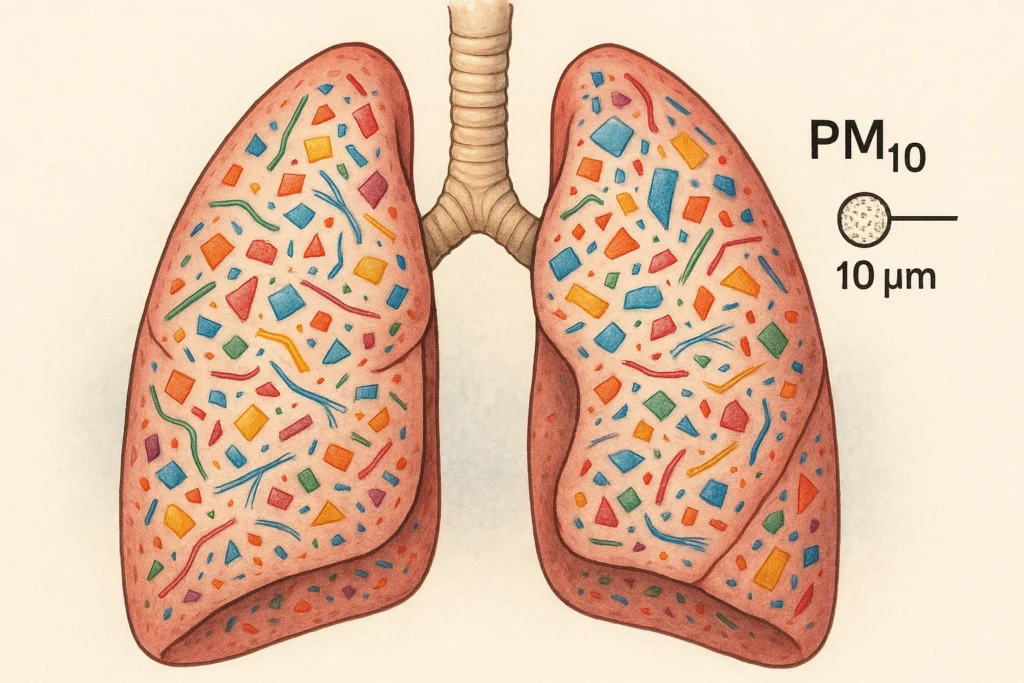Plastic is present in our modern world in everything we see- packaging and even clothes, but what if plastic is also in the air we inhale? An unlikely study published in PLOS ONE on July 30, 2025 by Nadiia Yakovenko and colleagues changes things by showing that we are breathing in thousands of microplastic particles (MPs) in indoor conditions daily. Such small pollutants, particularly, those of the size range PM10 (1-10 micrometers) may reach deep into our lungs and this causes severe health hazards. This research brings about the necessity to quit this invisible killer as people spend approximately 90 percent of their lives inside.
What Are Microplastics?
Microplastics are microscopic particles of plastics, which include clothing, furniture, packaging, and other everyday materials, among others. The air gets into the body through erosion and deposits as particles that are in suspension in the air and are inhaled. Although other studies have been conducted previously on the larger MPs (20-200 µm), mainly by the use of exiting techniques such as the micro-Fourier Transform Infrared (uFTIR) spectroscopy, the techniques used in the current study goes deeper into the smaller fraction of PM10 by utilizing the advanced Raman spectroscopy technique where its detectability is down to 1 2m in size.
The scientists took a sampling of air in residential apartments of Toulouse, France, and inside car cabins when driving. They employed vacuum pumps to trap aerosols on filters and analyzed them in classifying MP composition, shape and size. This scrupulous method, with blank corrections and recovery tests (81 percent efficiency), makes data reliable.
Key Findings: High Concentrations in Homes and Cars
The study found median MP concentrations of 528 MPs/m³ in homes and a staggering 2,238 MPs/m³ in car cabins—likely due to active ventilation and synthetic interiors. In one high-activity home sample, levels spiked to 34,404 MPs/m³, showing how movement stirs up these particles.
Polymer types varied by environment. In residences, polyethylene (PE) dominated at 76%, common in packaging and textiles. Car cabins had more polyamide (PA) at 25%, from upholstery, alongside acrylonitrile butadiene styrene (ABS) and polyethylene terephthalate (PET) from dashboards.
Shapes were mostly fragments (97%), not fibers, and 94% were under 10 µm, following a power-law distribution where smaller particles are exponentially more abundant. This size matters: MPs larger than 10 µm get trapped in the upper airways, but finer ones reach the lungs, potentially causing inflammation, oxidative stress, or even cancer by releasing toxins.
Inhalation Estimates: Everyday it is Shocking
Combining their data with existing literature, the team derived a consensus indoor MP concentration: 200 MPs/m³ for 10-300 µm and 4,300 MPs/m³ for 1-10 µm. Using EU inhalation rates (16 m³/day for adults, 11 m³/day for children), adults inhale about 3,200 MPs/day in the larger range and 68,000 in the finer PM10 fraction. Children face 2,200 and 47,000 MPs/day, respectively.
These figures are 100 times higher than prior extrapolations, underscoring the underestimation of risks. Extrapolating to nanoplastics (<1 µm), exposure could reach millions daily, though more data is needed. Inhaled MPs might not just affect lungs; cleared via mucus, they could enter the gut, adding to dietary intake (estimated at 553-858 MPs/day from food).

Health Implications and Broader Context
Air pollution is associated with millions of deaths each year by the World Health Organization but even worse, microplastics have been found. Such particles contain additives such as heavy metals and persistent organics, which affect hormones and immunity. Exposure to occupational factors in textile industries has exhibited high risks in lung cancer and this could present risks to car drivers through high cabin concentrations.
Indoor MPs are boosted 8-30 times in comparison to outdoors and increase exposure. The study’s power-law fit (y = 5979x^{-2.331}) integrates global data, providing a robust model for future assessments.
Reducing Exposure: Practical Steps
In order to reduce risks:
Wisely ventilate: Precisely filter vacuums and air purifiers with HEPA.
Select fabrics of nature: Prefer cotton rather than synthetics as a clothing and furnishing item.
Service vehicles: Cleaning interior will help in reducing wear.
Advocate: Endorse curbing of plastic manufacturing.
With massive levels of production of plastic, there is excessive pollution. It has been suggested to conduct more Raman-based studies to monitor MP1-10 microns and nano-based plastics and incorporate the same in health guidelines in this research.
The Future Road
Yakovenko makes one want to wake up: it is not that we are polluting oceans; we are inhaling plastic. Protecting our health can be done by source recognition and minimization of exposure. Be educated-technology like AI-enabled feeding back would be able to keep track of these pollutants in real time.
References and Resources:
Yakovenko N, et al. (2025). Human exposure to PM10 microplastics in indoor air.

